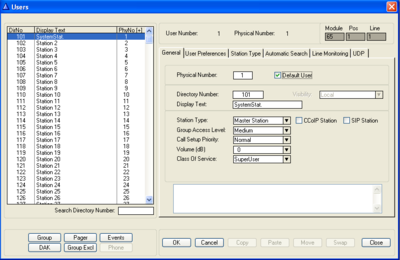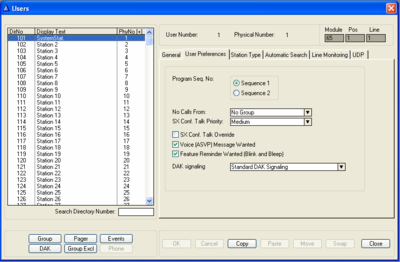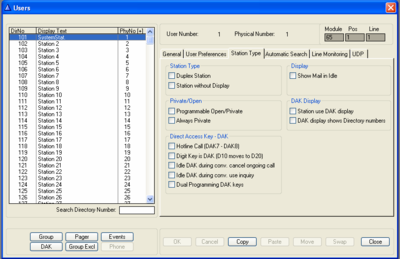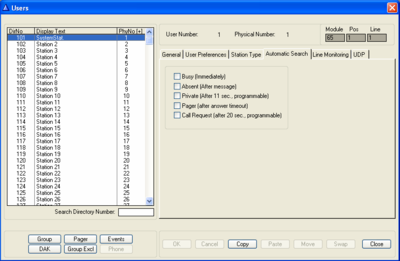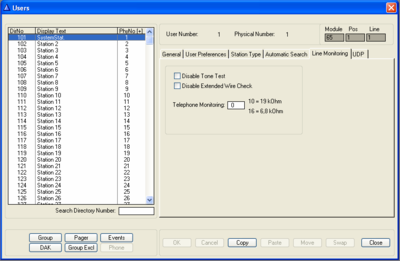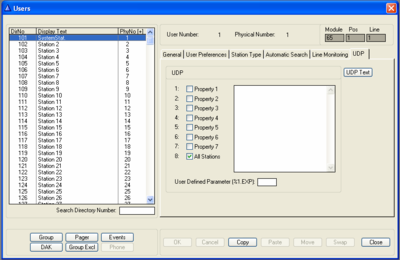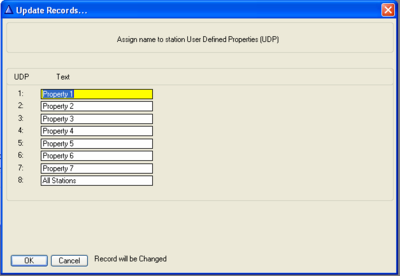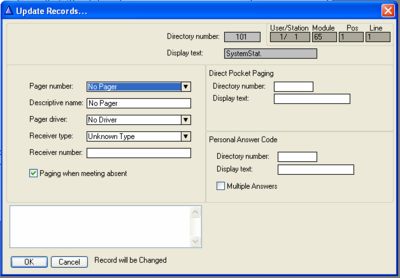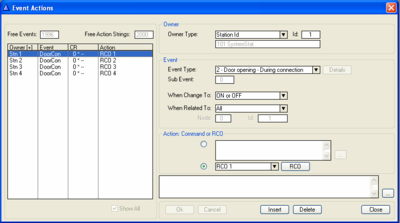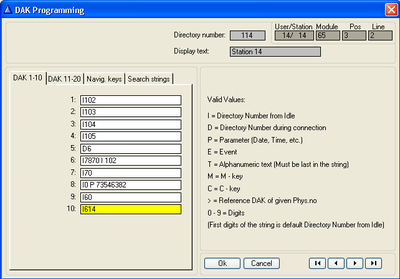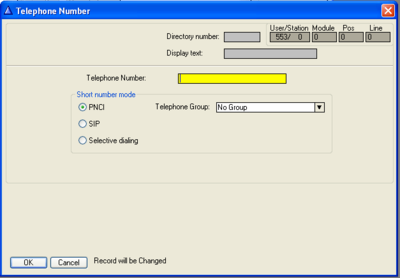Difference between revisions of "Users & Stations (AlphaPro)"
From Zenitel Wiki
(→Station Type) |
(→Station Type) |
||
| Line 102: | Line 102: | ||
!colspan="2"|Station Type | !colspan="2"|Station Type | ||
|-valign="top" | |-valign="top" | ||
| − | |Duplex Station||Sets the speech channel in open duplex for this station. | + | |Duplex Station||Disable voice switching, and Sets the speech channel in open duplex for this station. |
|-valign="top" | |-valign="top" | ||
|Station Without Display||Description Missing | |Station Without Display||Description Missing | ||
Revision as of 14:56, 26 September 2008
Contents
Users & Stations
| Search Directory Number | Description missing |
| User Number | Description missing |
| Physical Number | Description missing |
| Module | Description missing |
| Pos | Description missing |
| Line | Description missing |
General
| Physical Number | All stations are identified by the exchange with its physical number.
The physical number for a star wired station is the number of the physical wire connection point on the ASLT or ASLB card (see also section 11.2). IP stations must also be given physical numbers to follow the same logic. This number can be any number below 552, but must not overlap star wired station physical numbers.
|
| Directory Number | ‘Directory Number’ is the number to dial to reach the station. The default number can be changed to any 2-8 digit number starting with 1, 2, 3, 4 or 5. Numbers with first digit 6-9 are reserved for functions. If these numbers should be used, the corresponding function code must be changed. |
| Display Text | ‘Display Text’ is the station ID text shown in the called station’s display.
The default text should normally be substituted by the station location or the subscriber’s name. The max. number of characters is 16 including the station directory number. |
| Station Type | Select the type of station / device that is connected to the actual physical number. The following options are available:
If you select PNCI (Public Network Interface) as the station type, you will get a help dialog box to remind you what to program in the AlphaCom exchange to make the PNCI work; see page 91. Remember that the PNCI itself also has to be programmed. You do this from a terminal connected to the PNCI.
|
| Group Access Level | This is used to restrict access to group calls. Each group is assigned a group access level. A station must have the same or higher group access level to be allowed to make a group call to that group. Three levels are used: low - medium - high; see details on page 58. |
| Call Setup Priority | This setting specifies how outgoing calls from the station are treated; see table on page 41.
|
| Volume (dB) | This volume setting is used to compensate for volume loss on long lines, etc. Available values are -14 dB to 16 dB. The default setting is 0 dB. For ordinary regulation of the volume, the volume bar or the station is used. The exchange must be reset if the volume setting has been changed. |
| Class of Service | This setting determines the features in the system to which the station has access. There are 16 different classes available and each can be freely programmed. A station can only have one Class of Service defined. The following classes have a default setup (which can be changed):
|
User Preferences
| Program Seq. No | This determines the program sequence for the Program Step feature. Two options are available; see System Parameters on page 189. |
| No Calls From | Selects one group from which the station is not allowed to accept calls. |
| SX Conf. Talk Priority | This setting is used when this station is member of a simplex conference:
|
| SX Conf. Talk Override | This setting is used when this station is member of a simplex conference:
|
| Voice (ASVP) Message Wanted | This enables or disables the Voice Message Features for the selected station. This includes all absence messages, voice mail messages and voice help. |
| Feature Reminder Wanted (Blink and Bleep) | The feature reminder is a flashing LED and a bleep when there is mail on the station. This enables or disables the Feature Reminder for the selected station |
| DAK Signaling | Description missing |
Station Type
| Station Type | |
|---|---|
| Duplex Station | Disable voice switching, and Sets the speech channel in open duplex for this station. |
| Station Without Display | Description Missing |
| Private/Open | |
| Programmable Open/Private | [X] disables the private switch on the station or any private switch setting on the circuit board. You can then set the station in permanent private/open mode by dialing from the station: 7887 - station in private |
| Always Private | Description Missing |
| Direct Access Key DAK | |
| Hotline Call (DAK7 - DAK8) | Hotline: A pre-programmed number (DAK 7) is dialed when the handset is lifted. To program a hotline number, see page 81.
activates the hotline option for this station. |
| Digit Keys in DAK (D10 moves to D20) | means that the digit keys 0-9 dials pre-programmed complete numbers from the DAK table. If the station has DAK keys (incl. hotline), they move to DAK 80 |
| Idle DAK during conv. cancel ongoing call | Description Missing |
| Idle DAK during conv. use inquiry | Description Missing |
| Dual Programming DAK keys | Description Missing |
| Display | |
| Show Main in Idle | Description Missing |
| DAK Display | |
| Station use DAK display | Description Missing |
| DAK display shows Directory numbers | |
Automatic Search
| Busy (immediately) | Description Missing |
| Absent (after message) | Description Missing |
| Private (after 11 sec., programmable) | Description Missing |
| Pager (after answer timeout) | Description Missing |
| Call Request (after 20 sec., programmable) |
Line Monitoring
| Disable tone test | Description Missing |
| Disable Wxtended Wire Check | Description Missing |
| Telephone Monitoring | Description Missing |
UDP
| Property 1 | Description Missing |
| Property 2 | Description Missing |
| Property 3 | Description Missing |
| Property 4 | Description Missing |
| Property 5 | Description Missing |
| Property 6 | Description Missing |
| Property 7 | Description Missing |
| All Stations | Description Missing |
| User Defined Parameter(%1.EXP): | Description Missing |
| UDP | Text |
|---|---|
| Property 1 | Description Missing |
| Property 2 | Description Missing |
| Property 3 | Description Missing |
| Property 4 | Description Missing |
| Property 5 | Description Missing |
| Property 6 | Description Missing |
| Property 7 | Description Missing |
| All Stations | Description Missing |
Group
Pager
| Pager number | The pager identification used in the AlphaCom system. One of 200 pagers can be selected. |
| Descriptive number | Description Missing |
| Pager Driver | Decided by the type of pager system to which you connect the AlphaCom. The following pager driver options are available:
|
| Receiver type | The following receiver types are available:
|
| Receiver number | Must correspond to the ID given in the programming of the pager system. (Usually the number shown in the pager display when the pager is switched on). |
| Direct Pocket Paging | |
| Directory Number | Reflects information entered for the highlighted station in the listbox when pressing the pager key |
| Display Text | Here you enter the text you want to be used for any station display indication with direct pocket paging. |
| Personal Answer Code | |
| Directory Number | Description Missing |
| Display Text | Here you enter the text you want to be used for any station display indication with direct pocket paging |
| Multiple Answers | [X] Multiple Answer option is activated for this receiver.
Applies only to paging using the 47 code. Then you can send a message to a group of pagers and make it possible for all of them all to answer the paging. The pager group must be set up in the paging system. |
Events
| Owner | |
| Owner type | Description Missing |
| Event | |
| Event Type | Description Missing |
| Sub Event | Description Missing |
| When Change To | Description Missing |
| When Related To | Description Missing |
DAK
Group Excl
| Telephone Number | Description Missing |
| Short number mode | |
| PNCI | Description Missing |
| SIP | Description Missing |
| Selective dialing | Description Missing |
| Telephone Group | Description Missing |
Phone

